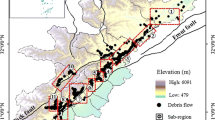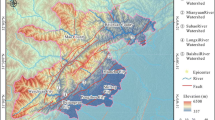Abstract
The Ms 8.0 Wenchuan earthquake greatly altered the threshold for rainfall-triggered debris flows in the affected areas. It is of both scientific and practical significance to determine the rainfall thresholds. This study examines one of the regions most prone to debris flows to analyze the characteristics of rainfall that caused debris flows, and to explore local rainfall thresholds. We applied the relation between rainfall intensity and duration, peak intensity and event amount, and other single factor approaches. Comparison of effectiveness and accuracy indicates that the event rainfall is the most sensitive factor for forecasting. Analysis of the annual rainfall thresholds showed that the rainfall conditions required for debris flows have increased on the continent during the past 6 years. Besides the rainfall fluctuations over the past few years, material changes were the primary reason for threshold variability. Recovery of vegetation plays an important role in reducing potential loose material that supplies volume for debris flows. Natural solidification, decrease of the potential erosion depth, and surface coarsening make it more difficult to initiate a debris flow, and ultimately increased rainfall conditions required. The change in rainfall thresholds can be predicted and verified for the entire earthquake-affected region.












Similar content being viewed by others
References
Aleotti P (2004) A warning system for rainfall-induced shallow failures. Eng Geol 73:247–265
Brunetti MT, Peruccacci S, Rossi M, Luciani S, Valigi D, Guzzetti F (2010) Rainfall thresholds for the possible occurrence of landslides in Italy. Natural Hazards and Earth System Sciences 10:447–458
Caine N (1980) The rainfall intensity-duration control of shallow landslides and debris flows. Geogr Ann Ser A Phys Geogr 62:23–27
Cannon S, Gartner J, Wilson R, Bowers J, Laber J (2008) Storm rainfall conditions for floods and debris flows from recently burned areas in southwestern Colorado and southern California. Geomorphology 96:250–269
Coe J, Kinner D, Godt J (2008) Initiation conditions for debris flows generated by runoff at Chalk Cliffs, central Colorado. Geomorphology 96:270–297
Cui P (1992) Studies on condition and mechanism of debris flow initiation by means of experiment. Chin Sci Bull 37(9):759–763
Cui P, Zhu YY, Chen J, Han YS, Liu HJ (2007) Relationships between antecedent rainfall and debris flows in Jiangjia Ravine, China. In: Chen CL, Major JJ (eds) Debris-flow hazard mitigation-mechanics, prediction, and assessment. Millpress, Rotterdam, pp 1–10
Cui P, Chen XQ, Zhu YY, Su FH, Wei FQ, Han YS, Liu HJ, Zhuang JQ (2011) The Wenchuan Earthquake (May 12, 2008), Sichuan Province, China, and resulting geohazards. Nat Hazards 56(1):19–36
Cui P, Zou Q, Xiang LZ, Zeng C (2013) Risk assessment of simultaneous debris flows in mountain townships. Prog Phys Geogr 37(4):516–542
Dahal R, Hasegawa S (2008) Representative rainfall thresholds for landslides in the Nepal Himalaya. Geomorphology 100:429–443
Gabet E, Burbank D, Putkonen J, Pratt-Sitaula B, Ojha T (2004) Rainfall thresholds for landsliding in the Himalayas of Nepal. Geomorphology 63:131–143
Gregoretti C (2000) The initiation of debris flow at high slopes: experimental results. J Hydraul Res 38:83–88
Gregoretti C, Fontana GD (2008) The triggering of debris flow due to channel-bed failure in some alpine headwater basins of the Dolomites: analyses of critical runoff. Hydrol Process 22:2248–2263
Guo XJ, Xiang LZ, Zhou XJ, Yang W (2012) Research on the debris flow hazards in Gaojia Gully and Shenxi Gully in 2011. J Catastr 27(3):81–85 (in Chinese with English abstract)
Guo XJ, Cui P, Li Y (2013) Debris flow warning threshold based on antecedent rainfall: a case study in Jiangjia Ravine, Yunnan China. J Mt Sci 10(2):305–314
Guo XJ, Cui P, Ma L, Kong YD (2014) Triggering rainfall characteristics for debris flows along Dujiangyan–Wenchuan Highway of Sichuan. Mt Sci 32(6):739–746 (in Chinese with English abstract)
Guo XJ, Cui P, Li Y, Zou Q, Kong YD (2015a) The formation and development of debris flows in large watersheds after the 2008 Wenchuan Earthquake. Landslides. doi:10.1007/s10346-014-0541-6
Guo XJ, Cui P, Li Y, Zhang JQ, Ma L, Mahoney WB (2015b) Spatial features of debris flows and their rainfall thresholds in the Wenchuan earthquake-affected area. Landslides. doi:10.1007/s10346-015-0608-z
Guzzetti F, Peruccacci S, Rossi M, Stark C (2007) Rainfall thresholds for the initiation of landslides in central and southern Europe. Meteorol Atmos Phys 98:239–267
Guzzetti F, Peruccacci S, Rossi M, Stark C (2008) The rainfall intensity-duration control of shallow landslides and debris flows: an update. Landslides 5:3–17
Hong Y, Hiura H, Shino K, Sassa K, Suemine A, Fukuoka H, Wang G (2005) The influence of intense rainfall on the activity of large-scale crystalline schist landslides in Shikoku Island, Japan. Landslides 2:97–105
Innes JL (1983) Debris flows. Prog Phys Geogr 7:469–501
Jibson R (1989) Debris flow in southern Puerto Rico. Geol Soc Am Spec Pap 236:29–55
Kong YD, Guo XJ, Zou Q, Zeng C, Yan YAN (2013) Giant Debris flow hazards in Guxi Gully, Wenchuan County of China on July 10, 2013. Mt Res 32(3):320–326 (in Chinese with English abstract)
Larsen M, Simon A (1993) A rainfall intensity-duration threshold for landslides in a humid-tropical environment, Puerto Rico. Geogr Ann Ser A Phys Geogr 75:13–23
Li Y, Zhou XJ, Su PC, Kong YD, Liu JJ (2013) A scaling distribution for grain composition of debris flow. Geomorphology 192:30–42
Lin CW, Shieh CL, Yuan BD, Shieh YC, Liu SH, Lee SY (2004) Impact of Chi-Chi earthquake on the occurrence of landslides and debris flows: example from the Chenyulan River watershed, Nantou, Taiwan. Eng Geol 71:49–61
Liu JF, You Y, Chen XC (2010) The characteristics and countermeasures of dam-breaking debris flow after Wenchuan Earthquake-a case study of the Tangfang Gully in Pingwu County, Sichuan Province. J Sichuan Univ (Eng Sci Ed) 42(5):68–75 (in Chinese with English abstract)
Peruccacci S, Brunetti MT, Luciani S, Vennari C, Guzzetti F (2012) Lithological and seasonal control on rainfall thresholds for the possible initiation of landslides in central Italy. Geomorphology 139–140:79–90
Saito S, Daichi N, Hiroshi M (2010) Relationship between the initiation of a shallow landslide and rainfall intensity-duration thresholds in Japan. Geomorphology 118:167–175
Shieh CL, Chen YS, Tsai YJ, Wu JH (2009) Variability in rainfall threshold for debris flow after the Chi-Chi earthquake in central Taiwan, China. Int J Sedim Res 24:177–188
Su PC, Wei FQ, Cheng ZL (2012) Debris flow activity of Mozi Gully after Wenchuan Earthquake on May 12. J Yangtze River Sci Res Inst 29(2):16–22 (in Chinese with English abstract)
Takahashi T (1978) Mechanical characteristics of debris flow. J Hydraul Div ASCE 104:1153–1169
Takahashi T (1991) Debris flow, monograph of IAHR. AA Balkema, Rotterdam
Tan WP, Han QY (1992) Study on regional critical rainfall indices of debris flow in Sichuan Province. J Catastrophology 7(2):37–42 (in Chinese with English abstract with English abstract)
Tang C, Zhu J, Li WL (2009) Rainfall triggered debris flows after Wenchuan earthquake. Bull Eng Geol Environ 68:187–194
Tang C, Li WL, Ding J, Huang XC (2011) Field investigation and research on giant debris flow on August 14, 2014 in Yingxiu Town, epicenter of Wenchuan Earthquake. Earth Sci J Geosci 35(1):172–180
Tang C, Van AT, Chang M, Chen GQ, Zhao XH, Huang XC (2012) Catastrophic debris flows on 13 August 2010 in the Qingping area, southwestern China: the combined effects of a strong earthquake and subsequent rainstorms. Geomorphology 139–140:559–576
Xie H, Zhong DL, Jiao Z, Zhang JS (2009) Debris Flow in Wenchuan Quake-hit Area in 2008. J Mt Sci 27(4):501–509 (in Chinese with English abstract)
Xu Q (2010) The 13 August 2010 catastrophic debris flows in Sichuan Province: characteristics, genetic mechanism and suggestions. J Eng Geol 18(5):596–608 (in Chinese with English abstract)
You Y, Liu JF, Chen XC (2010) Debris flow and its characteristics of Subao River in Beichuan County after 5.12 Wenchuan Earthquake. J Mt Sci 28(3):358–366 (in Chinese with English abstract)
You Y, Chen XC, Liu JF (2011) Dam-breaking debris flows and its countermeasures of Gangou Gully following the Wenchuan Earthquake in Anxian County Sichuan. J Mt Sci 29(3):320–327 (in Chinese with English abstract)
Yu B, Ma Y, Zhang JN, Wu YF, Zhang HH, Li L, Chu SM, Qi X (2011) The group debris flow hazards after the Wenchuan Earthquake in Longchi, Dujiangyan, Sichuan Province. J Mt Sci 29(6):738–746 (in Chinese with English abstract)
Zhang YS, Cheng YL, Yin YP, Lan HX, Wang J, Fu XX (2014) High-position debris flow: a long-term active geohazard after the Wenchuan earthquake. Eng Geol 180(8):45–54
Zhou W, Tang C (2014) Rainfall thresholds for debris flow initiation in the Wenchuan earthquake-stricken area, southwestern China. Landslides 11:877–887
Zhou W, Tang C, Zhou CH (2012) Critical rainfall characteristics for rainfall-induced debris flows in Wenchuan earthquake affected areas. Adv Water Sci 23(5):650–655 (in Chinese with English abstract)
Zhuang JQ, Cui P, Ge YG, Zhu YY, Liu YH, Pei LZ (2010) Risk assessment of collapses and landslides caused by 5.12 Wenchuan Earthquake—A case study of Dujiangyan–Wenchuan Highway. Chin J Rock Mech Eng 29(S2):3736–3742
Acknowledgments
The authors acknowledge the Meteorological Bureau of Sichuan Province for providing their rainfall data. This study was supported from the Key Deployment Project of Chinese Academy of Sciences (Grant No. KZZD-EW-05-01) and the National Natural Science Foundation (Grant No. 41301008), and National Key Technologies R&D Program of China (Grant No. 2012BAK10B04).
Author information
Authors and Affiliations
Corresponding author
Rights and permissions
About this article
Cite this article
Guo, X., Cui, P., Li, Y. et al. Temporal differentiation of rainfall thresholds for debris flows in Wenchuan earthquake-affected areas. Environ Earth Sci 75, 109 (2016). https://doi.org/10.1007/s12665-015-5031-1
Received:
Accepted:
Published:
DOI: https://doi.org/10.1007/s12665-015-5031-1




